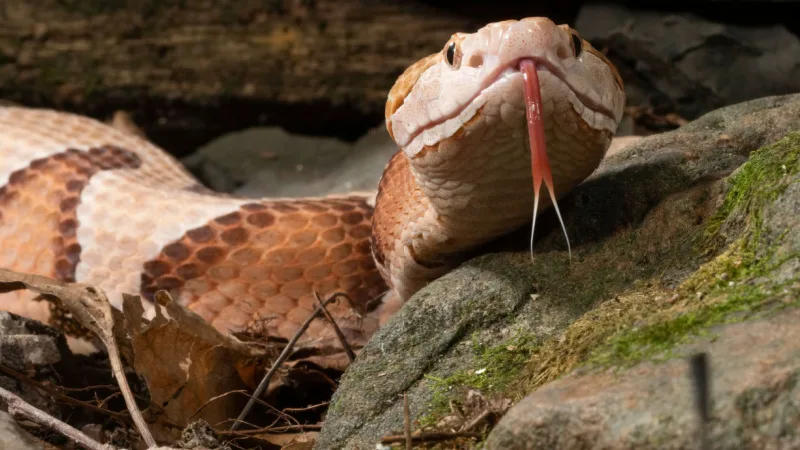What to Do If a Venomous Snake Bites Your Dog
Concerned that your curious dog might get bit by a venomous snake? Here are ways to identify deadly snakes, bite symptoms, and what to do in case of an emergency.

Rattlesnakes have gotten a bad rap for a good reason. According to the U.S. Food and Drug Administration, approximately 8,000 people are bitten by venomous snakes in the United States each year.
What about dogs? The U.S., unfortunately, doesn’t have a central database that states how many dogs are bitten by venomous snakes, so the number is unknown. However, that doesn’t mean pet owners shouldn’t be on the lookout for deadly reptiles.
Venomous Snakebites Could Be Deadly
Exploring nature with your dog is one of the best ways to provide exercise and engagement, but that doesn’t mean on-foot adventures are without their risks. Snakes could pique your pup’s interest, and result in a potentially deadly altercation.
Identification is key when determining whether or not your dog has been poisoned, but bringing the snake with you to the vet is the only way to accurately identify its type… and unnecessarily dangerous.
Here are some safe and quick identification tips for venomous snakes in the U.S.
Types of Poisonous Snakes
Stay away from these reptiles if you stumble upon them in your yard or on the trail.
Copperhead
**How to identify:**The top of the triangular head is a copper and orange color. There is no rattle, and the body has hourglass-shaped markings. The average length is 2 to 4 feet.
**Region:**Copperheads live everywhere from Northern Florida to Massachusetts in the east and westward to Texas and Nebraska.
Coral Snake
How to identify:“Red touching yellow is a dangerous fellow.” This is a common saying in the south because the Coral snake has red stripes next to yellow stripes. The average length is 3 feet.
**Region:**Coral Snakes are found in the Southeast, mainly from Texas to Florida.
Rattlesnakes (Three Types)
**How to identify:**The head is triangular with a discernible neck, and the tail has a rattle. These snakes are up to 8 feet long.
**Region:**Rattlesnakes can be found throughout most of the south, from California to Florida.
Eastern Diamondback Rattlesnakes, Timber Rattlesnakes, and Dusky Pygmy Rattlesnakes are all venomous types and can cause death.
Water Moccasin or Cottonmouth
**How to identify:**This snake keeps its entire body above water. The body is dark-colored with a triangular head and a white color in its mouth. The average length is 5 feet.
**Region:**This snake prefers swampy areas and streams. Cottonmouths live in Illinois, Missouri, Oklahoma, and Texas, northeast to Virginia, and South to Florida.
Signs of a Snakebite
Snakebites typically happen on the face or neck area of most dogs. If you suspect a snake bite, watch for the following signs and immediately go to the vet:
Signs of shock
Trembling or drooling
Swelling, bleeding, and redness at the bitten area
Bite marks on the dog’s skin, typically on the face or neck area
Pain
Difficulty breathing
The severity of the venomous snakebite depends on the species and size of the snake. The size of the animal bitten is another factor.
Call the Vet in Advance: Make Sure They Have Antivenin
Your vet may not have the appropriate antivenin! If that is the case, they’ll redirect you to a clinic prepped with the right one, so always call when you’re on your way.
What is Antivenin?
Antivenins neutralize the effects of the injected venom. A specific antibody is made for the above snakes, and each vial is expensive.
A Rattlesnake Vaccine Exists
A vaccine is available and helps build immunity against a rattlesnake bite. So, if your dog gets bitten, they’ll have some immunity causing less of a severe reaction and allowing you time to get to a vet. This is not considered a core vaccine.
Treating Snakebites
Can you safely identify the snake? Note its head shape and body markings, as this is very important when you call the vet, especially if you cannot bring the snake with you. It’s hard to tell the difference in some regions, so all bites should be treated as an emergency.
Immediately remove your dog’s collar
Check for signs of breathing difficulty
Look for signs of shock
Rinse the area with water to help flush away the leftover venom
Keep your dog calm
Transport your buddy to a vet right away and call them while in transit to ensure they have antivenin
Take some of the stress out of unexpected poisoning with Accident & Illness Coverage from AKC Pet Insurance (underwritten by Independence American Insurance Company). Our dog pet insurance plans are designed to be there when you need them, allowing you to focus more on the health of your pet and less on costly veterinary bills. Click here for a quote today!
Christy is a writer, editor, blogger, chicken keeper, and storyteller. She uses her knowledge as a certified veterinary technician to inform animal lovers on health and wellness topics. Christy's Standard Dachshund and Beagle mix are the inspiration behind her writing portfolio and essays.
READ MORE ARTICLES

